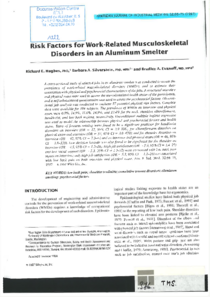Risk factors for work-related musculoskeletal disorders in an aluminium smelter

Hughes, Richard E. ; Siverstein, Barbara A. ; Evanoff, Bradley A.
American Journal of Industrial Medicine
1997
32
1
66-75
aluminium industry ; back disorders ; medical surveillance ; musculoskeletal diseases ; physical workload ; repetitive strain injury ; shoulder ; smelting plants ; tendinitis ; work posture
Musculoskeletal disorders (MSD)
English
Bibliogr.
A study of risk factors for work related musculoskeletal disorders (WMDs) among aluminum smelter workers was conducted. The study group consisted of 121 persons employed at an aluminum smelter that utilized prebaked electrodes in the Hall-Heroult process to recover aluminum from its ore. Sixty two were employed as carbon setters, 36 as crane operators, and nine were employed as carbon anode workers. The subjects were given structured health interviews and physical examinations to assess the prevalence of WMDs. The subjects completed a questionnaire to rate perceived job satisfaction, supervisory and coworker support, and demands and decision latitude in their jobs, and to provide information on episodes of physical and mental exhaustion. The subjects were observed while performing their jobs and the job activities were scored for the presence of 37 potential risk factors for WMDs using a job surveillance checklist approach. Possible associations between WMDs identified in the workers and the physical and psychosocial work factors were examined by unconditional multiple logistic regression techniques. The prevalence of WMDs in the neck, shoulder, elbow or forearm, hand and wrist, and low back regions of the subjects as determined by the interview and physical examination was 0.8, 14.9, 11.6, 14.9, and 17.4%, respectively. Job activities that involved prolonged forearm twisting were significantly associated with hand or wrist disorders identified during the interview, elbow and forearm disorders identified during the interview and physical examination, and shoulder disorders identified during the interview and both the interview and physical examination, odds ratios (ORs) 17, 37, 92, and 46, respectively. High perceived job satisfaction and low social support were significantly associated with low back pain reported during the interview, OR 5.3. High perceived job satisfaction alone was also a significant predictor of low back pain identified during both the interview and physical examination, OR 5.3. The authors conclude that both physical factors (forearm twisting) and psychosocial factors are risk factors for WMDs.
Digital
The ETUI is co-funded by the European Union. Views and opinions expressed are however those of the author(s) only and do not necessarily reflect those of the European Union or the ETUI.